
Objective
This is an exercise in the use of Gamma Ray and Sonic, Density and porosity Logs in conjunction with cores to make a well log correlation and sequence stratigraphic interpretation. This exercise uses simplified "Fantasy" data generated to teach the interpretive techniques used in the later exercises that involve bone fide carbonate margins, shelves and basins.
The interpretation process is divided into:
1. Using the sonic, density, porosity and gamma ray logs, establish the patterns of coarsening or fining upward cycles and relate these to deepening and shallowing in the geological section. Mark each cycle with an arrow to indicate the grain size variation and so its shoaling or deepening upward character. An arrow that is inclined to the left indicates that the grain size is coarser and so the water is becoming shallower while an arrow that is inclined to the right indicates that the grain size is finer and so the water is becoming deeper.
This step is important since it enables the subsequent regional correlation that will be based on specific log markers. For example, there are a few gamma ray spikes that indicate sudden deepening. You will see later that one of these spikes is identified as the most significant maximum flooding surface (mfs) for the whole sequence, the Ottokar shale. Overall the third order sequence character may be deduced by identifying the deepening and shoaling trend (from one mfs to the next). Additionally, some cycle boundaries also have clear log character change.
.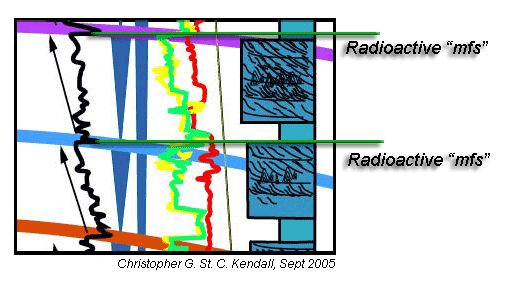
Shallowing up cycles
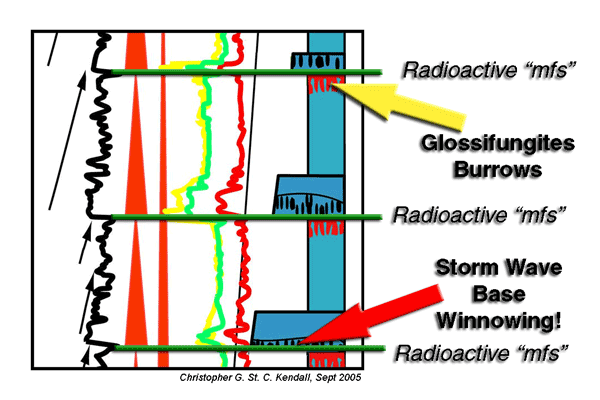
Deepening upward cycles
2. Examine the graphical display of the cores to establish the lateral and vertical distribution of lithofacies. Now identify all cycles (and/or parasequences). As given in the definition of cycles, each shoaling upward or deepening cycle is bounded by a maximum flooding surface. For instance the lower surface of a cycle might be the base of the deeper lithofacies layer that overlies the top of a shallowing upward cycle or the lower boundaformformry marks a shallower lithofacies layer which is overlain by a deeper lithofacies layer.
Just for a contrast mark each
cycle with triangles to indicate the
grain size variation and so its shoaling or deepening upward character. A triangle that points downward indicates that the
grain size is finer downward and so the water is becoming shallower upward while a triangle that is pointed upward indicates that the
grain size is finer upward and so the water is becoming deeper. Now determine whether the
cycles you identify from the cores can be tied to variations in the log character.
Data
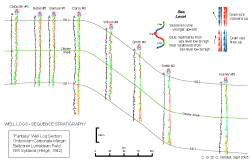
Company intelligence has acquired and provided you (the Chief Geologist of Monzanite Petroleum) with a cross section that displays the logs of eight "tight" wells that penetrate a portion of the Ordovician margin over the giant Beltzaren Lurrraldean Field of NW Syldavia (after Hergé 1939). These wells are from West to East the up-dip Calouste #3; Noble #5; Samuel #1; D'Arcy #3; Wilson #4; Smith; #4; Smith; #2; and the down-dip Kuenen #3. Each well has a full suite of Gamma Ray & Sonic, Density and porosity Logs and it is intended that you use the character of the logs to correlate the wells and predict their lithofacies. Geologists of the National Syldavian Oil Company (NASCO) have correlated the wells using an upper (SB1) and lower (SB2) sequence boundary, and a major maximum flooding surface (mfs) marked by the radioactive Ottokar shale.
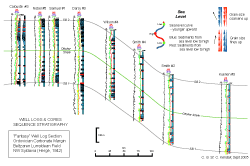
 Down load the un-interpreted well log cross section Printable Exercise 1 and Printable Exercise 2 which represent the log cross sections of eight wells penetrating a portion of the Ordovician margin over the giant Beltzaren Lurrraldean Field of NW Syldavia (after Hergé 1939). Use a mix of your understanding of carbonate sections and other the well log exercises to build an interpretive geological model. The pdf files can viewed on your PC Laptop, Notebook, Tablet, or Pad and interpreted with Power Point and its drawing tools, in particular the curve. This methodology is an effective and easy way to handle the objectives of the exercise and a means for collective viewing of results in class. Click on red box for more details. The output can be also be printed, and solved on paper.
Down load the un-interpreted well log cross section Printable Exercise 1 and Printable Exercise 2 which represent the log cross sections of eight wells penetrating a portion of the Ordovician margin over the giant Beltzaren Lurrraldean Field of NW Syldavia (after Hergé 1939). Use a mix of your understanding of carbonate sections and other the well log exercises to build an interpretive geological model. The pdf files can viewed on your PC Laptop, Notebook, Tablet, or Pad and interpreted with Power Point and its drawing tools, in particular the curve. This methodology is an effective and easy way to handle the objectives of the exercise and a means for collective viewing of results in class. Click on red box for more details. The output can be also be printed, and solved on paper.
Methods
Utilize the gulf coast slip-slide method to help you match the log sections and identify the same sections on the various wells. Color grain carbonates darker blue while the marls and shales should be lighter green-blue.
Correlate using the gamma ray peaks as markers. They are assumed to be equivalent to mfs.
When you make your interpretation of each cycle (probably not always parasequences) identify the mfs, and then starting from the base of the section upward correlate these for all the well logs provided. Examine the logs and indicate where sediments of the section fine-up or coarsen upward from the mfs. Now link the mfs surfaces from the base of the section upward from well to well. These surfaces may cap cemented horizons that can be equated with surfaces of transgression (TS) that formed at wave base, and above, when the sea floor was reworked just following a sea level low. The coarser sediments are assumed to be carbonate sands and in conjunction with the grain size and geometric stacking patterns of the carbonate a depositional model can be built. Click on the thumbnail below to view the two movies that demonstrates the techniques that use the mfs surfaces to build a framework of cycles (parasequences?) from these correlated surfaces and then interpret the core sections, again tracking grain size within each cycle. The first movie covers all eight wells while the second provides a close up of four of the wells used in the exercise so you can see the details of how to make this interpretation.
| Complete well log cross section used in carbonate sequence stratigraphic interpretation. |
|
 |
 |
| Carbonate well log of four of wells interpreted in exercises. grain size changes identified from logs and cores, establish cycle boundaries. |
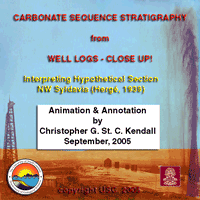
|
 |
 |
Click on links above to view YouTube and QuickTime movies of the output of the identification of log character to correlated and interpret the logs. The best way to view the YouTube movie frames is to first click on the pause symbol on the control bar and then use the mouse to grab the thumb (red circle) on the red seekbar (this tracks the progress of the movie) and move the thumb back and forth to chosen frames and so gain a better understanding of the evolving sedimentary geometries.
In contrast the best way to view the QuickTime movies is to control their motion using the arrow keys on your keyboard.
- The left arrow will step the film back
- The right arrow will step it forward
Now examine the cross section with the core data and indicate where the cycle breaks occur and how the grain size within each core varies vertically. Match your interpretations to the interpretation you made of the well logs alone. Note the difference in your interpretations of the well log sections versus that you made with the cores and see if you can establish why you had these differences.
Thus, as shown in the film make a cross-section, first correlate the prominent mfs for all the wells and then correlate the carbonate sands. Depending on your interpretation pick base and tops of the massive carbonate sands and correlate these from well to well when they occur on other logs in other wells. Either identify the sequence boundaries (SB) at the tops of the high stand massive sands or at the bases of low stand channel fill, and correlate these from well to well.
Make a cross-section tying the lime muds and finally carbonate sand geometries of all the wells. If you view the above movies and have read in the earlier sections on the geologic setting of carbonates and the introduction to the sequence stratigraphy of the carbonates you will know something of the depositional setting of these rocks. You should combine this understanding of the regional behavior of carbonates with your understanding of vertical and lateral facies relationships in near and offshore carbonate settings (e.g. shoreline, beach, stacked beaches, tidal flats, reefs, carbonate slope) and Walther's Law. You should use these to build a depositional model and a sequence stratigraphic interpretation of the well log section. They are based on several well log sections and field observations of the Late Permian carbonate shelf and reef margin complex of West Texas and New Mexico outcropping in the Guadalupe Mountains, and the Miocene reefs and platform of Mallorca. In both cases the sediment character is believed to exhibit a response to changing sea level and productivity. Pdf files containing a solution for wells and the cores can printed, reassembled and taped:
Printable Solution 1